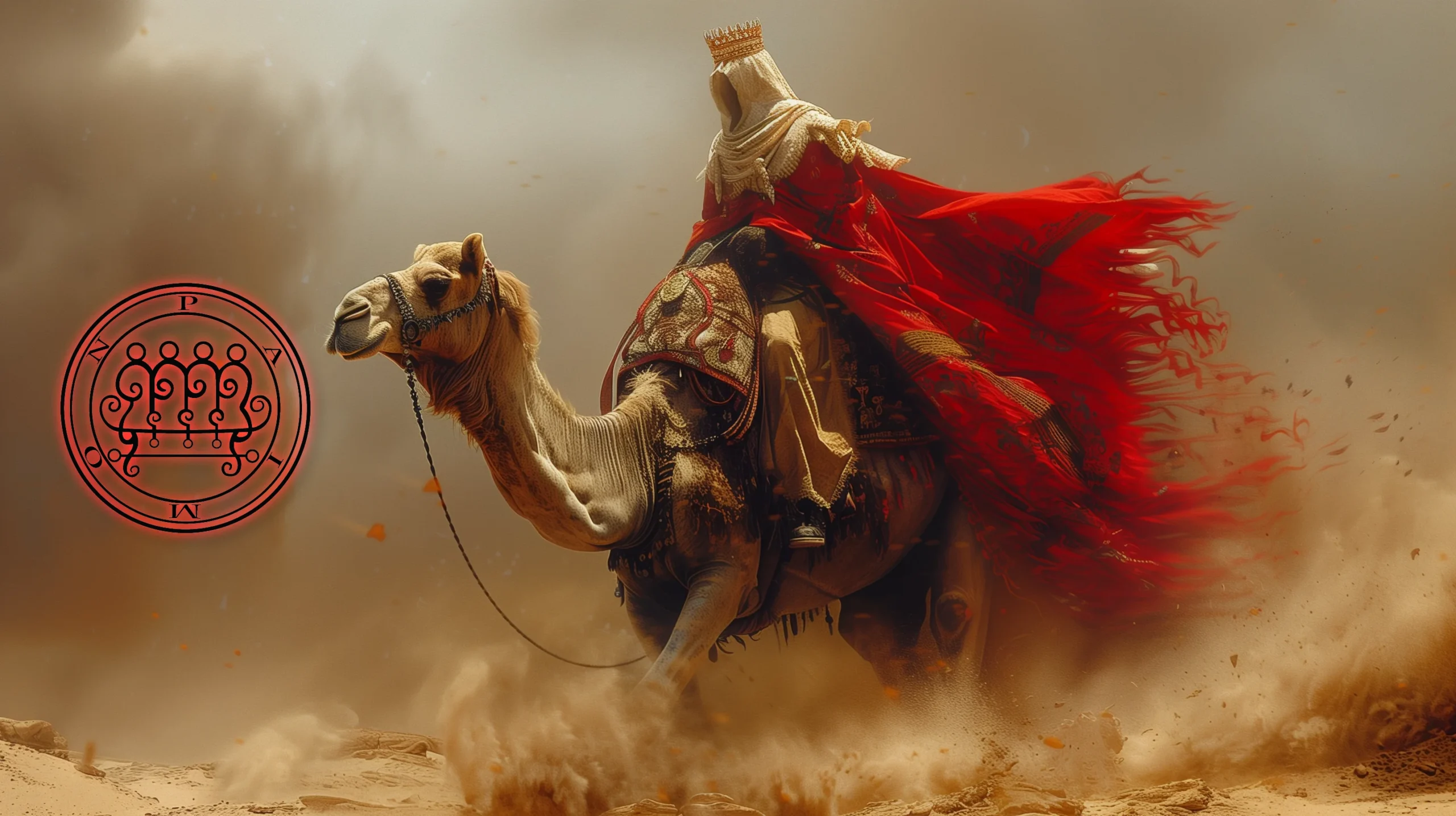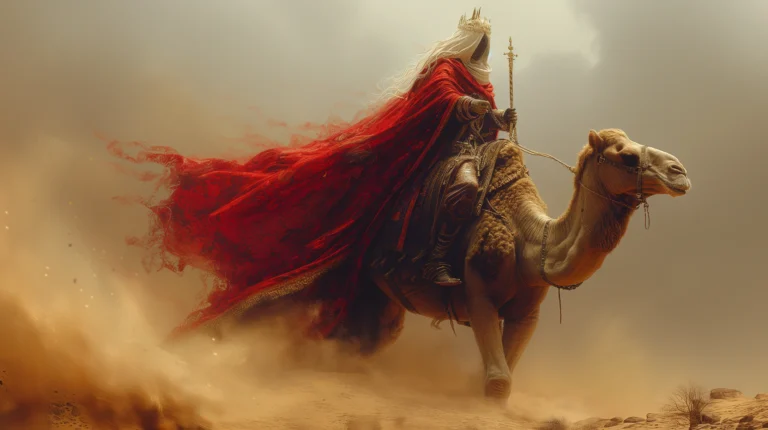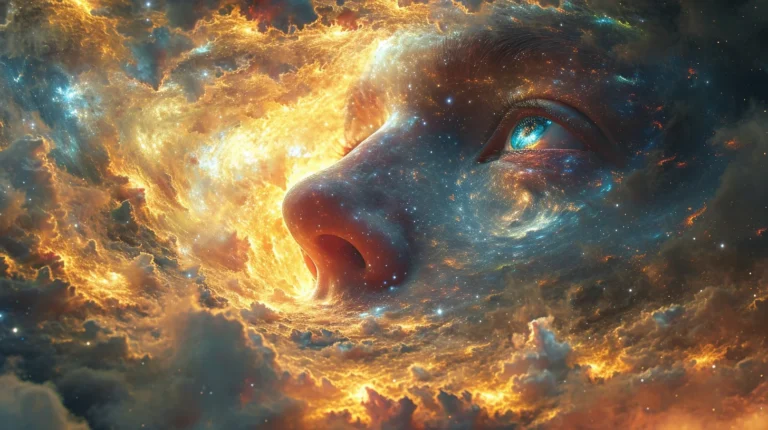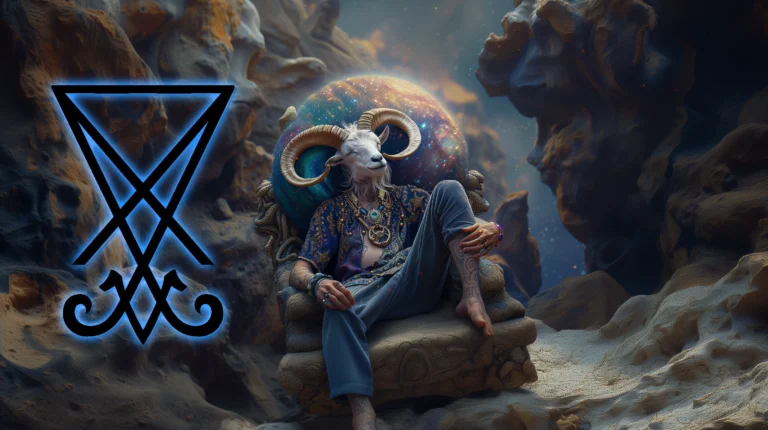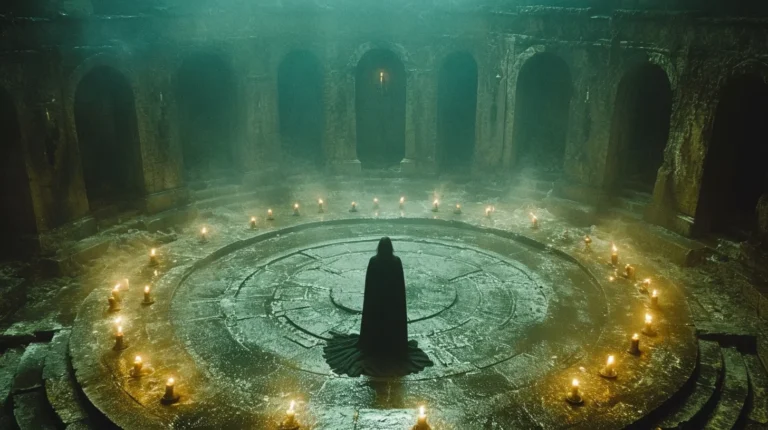Walking with King Paimon: A Modern Magician’s Guide
Preface
Welcome to a comprehensive exploration of King Paimon, a figure of profound wisdom and power within the Goetic tradition of magic. As the ninth spirit listed in the Goetia, King Paimon holds a position of significant importance, not only due to his rank but also because of the occult significance of the number nine. This guide delves into the multifaceted aspects of King Paimon, from his symbolic appearance to the deep, transformative knowledge he offers to those who seek to understand the mysteries he guards. In the words of Shakuntala Devi,
“Without mathematics, there’s nothing you can do. Everything around you is mathematics. Everything around you is numbers.”
King Paimon is traditionally depicted riding a dromedary camel, a being that defies simple categorization within the binary of male and female, embodying the transcendent nature of spirits. This appearance, rich in symbolism and archetypal significance, offers the first clue to the deep wisdom King Paimon can reveal. The choice of a dromedary camel not only underscores the spirit’s connection to vast, uncharted territories but also to resilience, endurance, and the ability to navigate through the complexities of the spiritual and material worlds. C.S. Lewis pointed out that,
“All things (e.g. a camel’s journey through A needle’s eye) are possible, it’s true. But picture how the camel feels, squeezed out In one long bloody thread, from tail to snout.”
The arrival of King Paimon is heralded by a loud, otherworldly sound, a phenomenon that carries its own symbolism. This sound, marking the thinning of veils between the worlds, prepares the practitioner for the profound revelations to come. It serves as a reminder of the power of sound in magical practices and the transformative potential of truly listening to the unseen. As stated by Yogi Bhajan,
“God created the universe with this sound of the gong, fly with it, spread your wings and go with it, flow away.”
King Paimon’s dominion extends over all arts and “secret Things,” encompassing the knowledge of the Earth, its waters, and the winds. This broad range of expertise is reflected in the archetypes of the Tarot, specifically the King of Swords, the King of Cups, the King of Pentacles symbolizing mastery over the intellectual, emotional and material realms, respectively. His strong association with the alchemical elements of Earth and Water further emphasizes his role as a guide through the depths of the subconscious and the mysteries of creation.
As a ruler of the West, a cardinal direction associated with the setting sun, King Paimon embodies the themes of closure, reflection, and the journey into the unknown. The invocation of King Paimon during sunset taps into the archetypal energies of endings and beginnings, guiding the practitioner through the cycle of death and rebirth that is central to magical practice.
At the heart of working with King Paimon is the journey into the subconscious mind, a realm where Carl Jung’s concepts of the shadow and the collective unconscious come to life. Engaging with King Paimon facilitates deep introspection and inner transformation, essential for any practitioner seeking to harness their true magical potential. In the words of Carl Jung,
“One does not become enlightened by imagining figures of light, but by making the darkness conscious.”
This guide also emphasizes the importance of dignity, respect, and self-perception in the relationship with King Paimon. Approaching him as a king and recognizing oneself as sovereign of one’s domain establishes a foundation of mutual respect, essential for a fruitful collaboration.
The path to connecting with King Paimon diverges from traditional material offerings, advocating instead for the offering of one’s dedication to personal growth and subconscious work. This reflects a modern understanding of spiritual practice as a mutual elevation towards an indescribable absolute reality.
As we venture into this exploration of King Paimon, remember that respect, self-awareness, and a willingness to confront the depths of one’s being are the keys to unlocking the profound wisdom and power he offers. This guide serves as a gateway to understanding not just a single entity but the interconnected web of existence and our place within it, guiding us towards our own sovereignty and mastery over the unseen forces that shape our world.
Also, if you are hesitant and perceive Paimon as a demon, please consider checking out our other book titled ‘Unveiling the True Nature of Demons: Magic and Spiritual Enlightenment.‘ Gustav Meyrink offered insight when he said,
“The devil is merely a metaphor for the journey inward that we all must take, towards our own hidden fears and desires.”
Introduction to King Paimon
King Paimon, recognized as a formidable and wise spirit, occupies a distinguished position within the Goetic hierarchy of spirits outlined in the Lemegeton, more commonly referred to as the Lesser Key of Solomon. This grimoire, a cornerstone in the tradition of Western occultism, catalogs seventy-two demons with instructions on their invocation, characteristics, and the seals required to summon them. King Paimon is introduced as the ninth spirit in this compendium, a detail that not only specifies his order of appearance but also hints at the layered symbolism and power attributed to him within the occult tradition.
Paimon is often seen as a figure riding a dromedary camel, with music from loud trumpets playing before him. Some stories say the camel wears a crown, while others say it’s Paimon himself who is crowned. Although described with a beautiful woman’s face, people usually refer to Paimon as ‘he’. However, since spirits don’t really have a gender, you can call Paimon whatever feels right to you based on the energy you sense. As Frederick Niche has articulated,
“Three metamorphoses of the spirit I named for you: how the spirit became a camel, and the camel a lion, and finally a child.”
In Nietzsche’s view, reaching our fullest potential requires embracing challenges and stepping out of our comfort zones. This journey mirrors the transformation of a spirit through three stages: the camel, the lion, and the child.
The camel represents endurance and resilience, bearing the weight of challenges and societal expectations, much like an artist striving through hardship. This stage is about survival and carrying burdens, akin to wearing the camel’s crown in the desert of trials.
Transitioning to the lion symbolizes claiming freedom and mastery over one’s domain, breaking free from external constraints, the “great dragon” of imposed rules. In this phase, the spirit, like King Paimon wearing his crown, asserts dominion, challenging the status quo to forge its path.
Finally, the spirit evolves into the child, embodying creativity, new beginnings, and the capacity to see the world with fresh eyes. This stage is about transcending old values and inventing new ones, reflecting King Paimon’s guidance towards self-realization and the creation of one’s destiny.
Through this allegory, we’re reminded of the power within us to evolve, from bearing burdens to ruling our domain, and ultimately, to reinventing ourselves and the world around us, guided by the timeless wisdom of figures like King Paimon.
Paimon’s voice is deep and rough, but you have to ask him to speak clearly. At first, he might speak in his own language, but if you ask him, he will talk in your language.
In the hierarchy of spirits within the Goetia, King Paimon’s title as “King” is of significant importance. This rank not only highlights his authority over other spirits but also aligns with the broader symbolic use of titles within the grimoire, where kings are often seen as governing entities with vast domains and capabilities.
King Paimon’s primary domain is the subconscious mind. Don’t underestimate its power; imagine the changes that can occur within your subconscious mind and how they can facilitate manifestation in the material world. Additionally, did you know that the subconscious mind constitutes 95 percent of the brain, while the conscious mind comprises only five percent? If we can learn to access our subconscious, we have the power to unlock our full potential, both personally and professionally.
The number nine, associated with King Paimon by virtue of his placement in the Goetia, carries its own set of occult significances. In various mystical traditions, the number nine is seen as a number of completion, representing the culmination of philosophical and spiritual quests. It symbolizes the end of a cycle and the potential for new beginnings, echoing the cyclical nature of learning and understanding that King Paimon embodies. The number nine, being the highest single-digit number, encompasses all the vibrational frequencies of the numbers preceding it, making it a number of universal, or rather, cosmic significance.
Let’s explore the deep occult significance of the number nine to better understand what it means to work with King Paimon. The number nine symbolizes the complete cycle of life, leading to a reset or return to the beginning, as seen in gematria.
It represents the highest level at which the divine becomes manifest in our world. Thus, the number nine holds profound spiritual significance, symbolizing ‘everything’ in ancient Chinese culture. It embodies the unity of three important elements and marks the stages of initiation across three realms on any spiritual journey.
In astrology, the number nine is linked to Mars, highlighting the risks of rash actions and impulsive decisions. Hastily spoken words or actions might lead to conflicts or even accidents. However, Mars also brings positive qualities like unbeatable resourcefulness, organizational skills, intellectual prowess, creativity, and influence.
The essence of the number nine is that it marks the end of a life cycle, which can lead to significant changes in circumstances or perspectives, encouraging a shift in lifestyle for those on a path of personal development.
Ultimately, the impact of the number nine on your life, whether positive or negative, depends on the nature of the energy you’ve invested in your endeavors.
Symbolism and Appearance of Paimon
King Paimon’s distinctive appearance, riding a dromedary camel, is rich in symbolic meaning and reflects his profound connection to the ancient and the mystical. The dromedary camel, a creature known for its endurance, resilience, and ability to navigate through challenging environments, especially deserts, is emblematic of the spirit’s capacity to traverse the vast and often arid landscapes of the human psyche and the spiritual realm.
Furthermore, the camel’s ability to store nourishment and water in its body to survive long periods without external resources mirrors the idea that the wisdom King Paimon imparts is both sustaining and self-sufficient, equipping the practitioner with inner resources to face spiritual challenges.
The path that King Paimon offers is one of profound self-understanding, achieved by delving into the depths of your subconscious mind. This journey helps you to manifest your true will, rather than being influenced by external forces like politicians, media, and societal expectations. Understanding your subconscious is crucial because it holds the key to your true desires, fears, and motivations. Without this knowledge, you’re at risk of losing your sense of self, as you may end up conforming to what others believe you should be, thereby losing your authenticity.
The subconscious mind is a vast, underlying layer of your consciousness that operates below the level of conscious thought. It stores your beliefs, memories, skills, experiences, and the emotions associated with them. Carl Jung once said,
“Until you make the unconscious conscious, it will direct your life and you will call it fate.”
This quote highlights the power of the subconscious mind in shaping your life’s direction, often without your conscious awareness.
The subconscious communicates through symbols, dreams, and intuitive feelings, making it a rich source of wisdom and insight if you know how to access and interpret its messages. Understanding your subconscious mind allows you to uncover and change limiting beliefs, heal past traumas, and align your conscious actions with your deeper desires, leading to a more authentic and fulfilling life.
Techniques to Explore the Subconscious Mind
- Meditation and Mindfulness: Regular meditation helps quiet the conscious mind, allowing the subtle messages of the subconscious to emerge. Mindfulness practices help you become more aware of your underlying patterns and triggers.
- Dream Journaling: Dreams are the language of the subconscious mind. Keeping a dream journal and reflecting on your dreams can provide insights into your inner desires, fears, and parts of yourself that need healing or development.
- Automatic Writing: This technique involves writing without conscious thought, allowing your subconscious to express itself. Set a timer, focus on a question or issue you’re dealing with, and let your hand write whatever comes without censoring or analyzing.
- Visualization: Visualization exercises can help you connect with your subconscious desires and intentions. By regularly visualizing your goals as already achieved, you can uncover and remove subconscious blocks to your success.
- Hypnotherapy: Hypnotherapy can be a powerful tool for accessing the subconscious mind. It uses guided relaxation and focused attention to achieve a heightened state of awareness, allowing for direct communication with the subconscious. You can practice self-hypnosis, which is very beneficial. Do your own research on it as well. We will also incorporate guided meditation at the end of the guide to connect with Paimon.
By engaging in these practices, you begin to unveil the mysteries of your subconscious mind, gaining the clarity and knowledge needed to live authentically according to your true will. King Paimon’s path is one of deep introspection and self-discovery, guiding you to a life where you are not merely reacting to the external world but actively creating your reality based on a profound understanding of your inner self.
The Archetypal Meaning of Paimon’s Visage
King Paimon’s visage, often described as a figure with a woman’s face, embodies the integration of masculine and feminine energies, reflecting the balance and harmony essential for true wisdom and understanding. This androgynous aspect suggests the transcending of dualities, encouraging the practitioner to look beyond the surface and recognize the interconnectedness of all things. Paimon’s face, embodying feminine beauty and grace, juxtaposed with a traditionally male title of “King,” serves as a powerful symbol of unity, wholeness, and the amalgamation of diverse forces.
In the material aspect of consciousness, we can liken our existence to that of Matryoshka Dolls, the Russian nesting dolls, where each layer represents different facets of our being, from the most physical to the most spiritual. In this material realm, we manifest as male or female aspects of energy, embodying the alchemical principles of masculine and feminine energies, which play a crucial role in our journey of ascension towards higher states of consciousness.
Alchemical male energy, traditionally symbolized by the sun, represents qualities such as logic, reason, action, and assertiveness. It’s the force that drives us to take action, to build, create, and manifest our ideas in the physical world. This energy is characterized by its outward focus, aiming to transform thoughts and dreams into tangible outcomes. In the alchemical tradition, it is associated with the element of fire, symbolizing the power to initiate change and the courage to overcome obstacles.
On the other hand, alchemical female energy, symbolized by the moon, embodies intuition, receptivity, creativity, and nurturing. It represents the inward focus, the realm of emotions, dreams, and the subconscious mind. This energy is associated with the element of water, reflecting its fluid, adaptable nature, and its role in the process of inner transformation and healing. Female energy nurtures and sustains the seeds of ideas planted by male energy, allowing them to grow and flourish.
In our journey through life, some individuals may find themselves resonating more with male energy, while others may feel more aligned with female energy. Yet, there are those who embody a balance of both, reflecting the complexity and diversity of human experience. Regardless of where we find ourselves on this spectrum, the goal remains the same: to work together, integrating these energies within ourselves to ascend towards our higher self.
King Paimon’s depiction with a female face and a male presence is a profound symbol of this ascension over duality. It represents the transcendence beyond binary concepts of right and wrong, male and female, embracing the gray areas that constitute the whole of existence. This symbolism serves as a reminder that the path of ascension is infinite, with ever-higher states of consciousness to explore. The ultimate reality, the one, the All, remains a mystery beyond the grasp of any single entity, whether they be angels, demons, or prophets. What is shared through experiences, visions, or teachings are interpretations of the infinite facets of this ultimate reality, not the entirety of it.
Thus, King Paimon embodies the principle that true wisdom lies in embracing and transcending dualities, acknowledging the limitless nature of ascension. As we navigate our spiritual journey, we are encouraged to integrate the masculine and feminine energies within us, moving beyond simplistic categorizations to embrace the complexity of our being. This integration is a key step in our evolution towards higher awareness, where the distinctions between spirit and matter, self and other, begin to dissolve, revealing the interconnectedness of all things in the journey towards the absolute. Carl Jung proposes that,
“Know all the theories, master all the techniques, but as you touch a human soul be just another human soul.”
The Entrance of King Paimon
The entrance of King Paimon is heralded by a unique auditory phenomenon: a loud sound that precedes his arrival. This sound, often described as a cacophony or a harmonious blend depending on the practitioner’s perception, is not merely an announcement of his presence but carries deep symbolic significance.
In many esoteric traditions, sound is recognized for its power to alter consciousness, break down barriers, and signal the beginning of transformative experiences. The loud sound accompanying King Paimon’s entrance can be interpreted as the shattering of the ordinary perception of reality, a call to attention for the practitioner, signifying that the boundaries between the worlds are being crossed.
This sound serves as a metaphysical boom, a signal that something profound and extraordinary is about to take place. It is as if the sound itself cleaves through the fabric of the mundane to usher in the presence of the supernatural. For the practitioner, this sound marks the moment of departure from the everyday and an entry into a sacred space of heightened awareness and deepened understanding.
In the context of King Paimon’s arrival, the loud sound embodies several layers of symbolism:
- Initiation and Transformation: The sound symbolizes the initiation of the practitioner into a deeper level of magical practice. It signals the commencement of a transformative journey under King Paimon’s guidance, preparing the practitioner for the revelations to come.
- Clarity and Understanding: Just as a sudden loud sound can momentarily clear the mind of all thoughts, the sound accompanying King Paimon’s entrance symbolizes the clarity and understanding that he brings. It represents the moment of epiphany, where confusion gives way to insight.
- The Power of Creation: In many traditions, the world is said to have been created through sound or a word. The sound heralding King Paimon echoes this primordial act of creation, reminding the practitioner of the creative potential of sound and the power of the spoken word in magical practice.
- Barrier Breaking: The loud sound signifies the breaking down of barriers, both within the practitioner and between the worlds. It marks the dissolution of the veils of illusion, allowing for a direct encounter with deeper spiritual truths under King Paimon’s tutelage.
Through this multifaceted symbolism, the sound that announces King Paimon’s arrival is not just an auditory experience but a richly layered symbol of spiritual awakening, transformation, and the profound changes that accompany deep magical work.
Paimon’s Domain of Knowledge
King Paimon’s expertise in the knowledge of the Earth, its waters, and the winds not only positions him as a guardian of elemental secrets but also as a guide for those seeking to understand the deeper truths of the natural world and the cosmos.
The King of Swords in the Tarot embodies intellect, authority, and clarity of thought. This archetype, when related to King Paimon’s knowledge of winds, symbolizes mastery over the mind and communication, akin to how the winds move and spread ideas across the world. The winds, in many cultures, are associated with messages from the supernatural, change, and the unseen forces that influence our lives. Paimon’s command over this element suggests an ability to offer clear insight, to cut through confusion with the precision of thought, and to influence the mental and communicative aspects of existence. This connection underlines Paimon’s role as a teacher of secret wisdom, enabling the practitioner to harness the power of thought, word, and intellect in their spiritual and magical practices.
In alchemy, the elements of Earth and Water are fundamental, representing physicality, intuition, emotion, and the unconscious. Earth symbolizes stability, fertility, and materiality—attributes that are essential for growth and transformation. Water, on the other hand, represents fluidity, intuition, and the depths of the psyche, reflecting the ever-changing and adaptable nature of emotions and the subconscious mind.
King Paimon’s strong association with these elements underscores his ability to navigate and teach the mysteries of the physical world as well as the depths of the subconscious. Through mastery over Earth, Paimon can guide one in grounding their magical practices in the material world, manifesting desires and understanding the sacredness of the physical realm. His connection with Water signifies his ability to help in navigating emotional depths, enhancing intuition, and fostering a deeper connection with the subconscious.
The King of Pentacles and the King of Cups are Tarot archetypes that resonate with the alchemical elements of Earth and Water, respectively, and provide further insight into Paimon’s domain of knowledge.
- King of Pentacles: This archetype represents mastery over the material world, abundance, and a pragmatic approach to life. It reflects Paimon’s connection with the Earth element, emphasizing his ability to guide practitioners in matters of material success, prosperity, and the utilization of resources. The King of Pentacles embodies the virtues of stability, reliability, and the capacity to manifest ideas into tangible reality, qualities that Paimon imparts to those who seek his knowledge.
- King of Cups: Representing the mastery of emotions, intuition, and the unconscious, the King of Cups aligns with Paimon’s association with the Water element. This card symbolizes emotional balance, compassion, and a deep understanding of the human psyche. It reflects Paimon’s ability to assist practitioners in exploring their inner worlds, managing their emotions wisely, and accessing deeper layers of intuition and creativity. Through the King of Cups, the qualities of empathy, emotional intelligence, and psychic abilities are highlighted as central to Paimon’s teachings.
The amalgamation of these archetypes and elements within King Paimon’s domain offers a comprehensive framework for understanding the breadth of his wisdom. Through engaging with King Paimon, one is invited to explore the depths of their being and the mysteries of the universe, armed with the knowledge and tools necessary for profound transformation and self-realization.
Paimon and the Collective Unconscious
Carl Jung, a Swiss psychiatrist and psychoanalyst, introduced the concept of the collective unconscious, a part of the unconscious mind which is shared among beings of the same species and contains the memories and knowledge of the entire species. This collective unconscious is home to archetypes, universal, mythic characters residing within our collective unconscious. Jung’s exploration into the depths of the subconscious reveals the powerful influence archetypal images and symbols have on the individual’s psyche and how they shape our experiences and behaviors.
Let’s take a closer look at the collective unconscious, a concept that helps us understand shared patterns of behavior and thought across humanity. The collective unconscious is filled with archetypes, which are like built-in forms or patterns of behavior we all share. These patterns include experiences like being born or dying, and figures like the trickster or the hero.
Carl Jung, who introduced these ideas, explained that these patterns are very old and common to everyone. They show up in our lives as certain events, characters, or themes, like the creation of the world or the end of times. Jung pointed out that we have countless archetypes because life presents us with countless typical situations. Through our repeated experiences, these patterns have become part of us.
Jung talked about several key archetypes like the shadow (our darker side), the wise old man, the child, the mother, the maiden, and the anima (the feminine side in men) and animus (the masculine side in women). These archetypes come alive in our minds and actions when we interact with the world. They act like living personalities inside us, shaping our behavior in ways we might not even realize.
Jung clarified that archetypes aren’t specific mythological images but the tendency to create these images. They are possibilities for how we see and act in the world. This is an important point because it shows that archetypes guide us towards becoming whole, a process Jung called individuation. This process involves bringing these hidden parts of ourselves into the light of consciousness.
Before Jung, psychology focused mostly on the personal aspects of the mind. But Jung showed that our actions are also driven by these shared instincts or archetypes. Understanding them helps us see beyond our personal experiences to the common patterns that influence all of humanity. Jung argued that these archetypal motifs are not just personal but are rooted in our biology and shared history.
The idea is to relax, delve inward, and introspect to discover which archetype you embody. These archetypes, neither good nor bad, are vital to human psychology and immensely useful. However, issues arise when you embody an archetype against your will. For instance, if the media influences you to adopt the patriotic archetype, you should question whether this truly resonates with your values and authenticity. It’s not inherently good or bad, but is it being used to manipulate or push an agenda? King Paimon’s key message is to be conscious and understand the workings of the material realm. We may embody various archetypes, but we should not be confined to just one. With King Paimon, embrace the archetype of a magician, adapting and changing like clothes.
In summary, Jung’s work on the collective unconscious and archetypes opens up a vast world of understanding about how deeply connected we are through shared patterns of thought and behavior. It’s not just about exploring our personal minds but discovering the universal themes that bind us all.
King Paimon, as a spirit of the Goetia, can be seen as one such archetype, embodying wisdom, knowledge, and the power of transformation. His association with the subconscious mind suggests his role as a mediator, enabling individuals to access and navigate the deeper aspects of their psyche. By working with King Paimon, practitioners are encouraged to confront and integrate their shadow selves, unearthing hidden fears, desires, and potentials, thus facilitating a process of self-realization and individuation as described by Jung.
Magic, in many traditions, is understood not merely as the manipulation of external forces but as a profound psychological process that involves the transformation of the self. The inner workings of magical practice involve introspection, visualization, and the use of symbols and rituals to effect changes in the subconscious mind, which in turn manifest in the external world.
The process of working with King Paimon becomes an act of inner alchemy, where the practitioner’s base elements—fears, doubts, and unacknowledged parts of the self—are transmuted into gold, symbolizing wisdom, strength, and self-awareness. The emphasis on inner transformation underscores the belief that the power of the magician stems from their ability to understand and harness the forces within themselves.
In the context of magical practice, working with King Paimon and engaging with the subconscious mind is a pathway to unlocking one’s full potential. The ultimate aim is not just personal gain but the elevation of the soul towards a greater understanding of the self and the cosmos, a journey that is deeply psychological yet imbued with spiritual significance. As illustrated by Carl Jung,
“The one thing we refuse to admit is that we are dependent upon ‘powers’ that are beyond our control.”
The Relationship with King Paimon and Gnosis
The dynamic relationship with King Paimon is founded on mutual respect and dignity, marking a departure from traditional notions of subservience in spirit work. This section delves into the nuances of building a relationship with King Paimon and my personal gnosis with him.
King Paimon’s interactions with practitioners are characterized by a profound sense of mutual recognition and respect. From the outset, he acknowledges the practitioner’s sovereignty, mirroring the dignity they afford him. This reciprocal acknowledgment forms the bedrock of a relationship built on respect rather than fear or subjugation.
By addressing him as “King Paimon,” practitioners recognize his authority and wisdom, setting the stage for a respectful and productive dialogue. As the relationship matures, the formality of titles may give way to a more familiar address, signifying a deepening bond and mutual understanding. This evolution in how Paimon is addressed mirrors the growth and transformation within the practitioner, marking milestones in their spiritual journey.
King Paimon teaches the importance of self-respect and sovereignty in magical practice and beyond. Practitioners are encouraged to approach him with the confidence and dignity of a king, regardless of their personal circumstances or self-perceptions. This approach is not about arrogance but about recognizing one’s innate worth and potential for greatness. King Paimon’s guidance is aimed at empowering individuals to claim their sovereignty, to rule over their domain with wisdom and compassion. This stance is a potent reminder that respect for oneself and others is foundational to any meaningful interaction, especially when engaging with powerful spiritual entities.
A critical aspect of the relationship with King Paimon is the clear stance against worship. King Paimon, like many entities of his stature, seeks respect and recognition, not blind adoration or subservience. This distinction is crucial in the practice of modern magic, where the empowerment of the practitioner is a key goal. Worship, in this context, is seen as a relinquishment of one’s power and sovereignty, an act that neither benefits the practitioner nor is desired by King Paimon.
Instead, the emphasis is on partnership and collaboration, where both parties bring their strengths and knowledge to the table, working together towards mutual goals. This approach fosters a sense of personal responsibility and empowerment, encouraging practitioners to stand as equals in their engagements with the spirit world.
When considering what to offer King Paimon, it’s essential to reflect on the nature of help and exchange. Why do we help others? If the motive is solely to gain something in return, this represents the most basic form of assistance. However, beings like King Paimon operate on a higher level of understanding, embodying the principle that we are all interconnected and must collaborate to progress spiritually.
Helping others without expecting anything in return elevates our energy, facilitating our ascent on the spiritual ladder. This selfless act allows us to use our heightened energy to manifest our desires in the physical world. It’s important to recognize that while our world is defined by duality, where give and take are often expected, the relationship with entities like King Paimon transcends this simplicity.
King Paimon assists us not for personal gain but as part of the universal flow of ascension. By aiding us, he elevates himself, and we, in turn, elevate ourselves by assisting others. This cycle of mutual support and elevation is the essence of our interconnected existence. The truth in this dynamic is straightforward: by contributing to the well-being of others without seeking personal benefit, we align ourselves with the fundamental laws of the universe, fostering our spiritual growth and the manifestation of our material desires.
Before we delve into the act of helping others and elevating together, it’s crucial to embrace another fundamental truth: the importance of loving and having compassion for yourself first. This self-love and compassion are the bedrock upon which you can build your ability to extend genuine care and assistance to others. Without a foundation of self-love, any attempt to help can become tainted by less altruistic motives, such as fear, guilt, or a sense of superiority.
Loving yourself isn’t about selfishness; it’s about acknowledging and nurturing your worth, which enables you to share that love more freely and authentically with others. Helping others should never stem from guilt or an attempt to alleviate personal discomfort. Similarly, gratitude should not be expressed from a place of comparison, where it becomes a veiled form of self-congratulation. True gratitude appreciates the experience itself and recognizes the mutual growth opportunities it provides, without placing oneself above or below others in the process.
As you journey through life, remember to compare yourself only to who you were yesterday, not to the perceived journey of others. This internal benchmark fosters a healthier form of growth, rooted in self-improvement and personal development, rather than competition or envy.
Being kind to yourself, extending that kindness to others, and contributing positively to society are integral steps on the path of ascension. This approach not only elevates your own spirit but also contributes to the upliftment of those around you, creating a ripple effect of positive energy and transformation within the collective consciousness.
Therefore, when engaging with King Paimon, consider offerings that reflect a genuine desire to grow, learn, and contribute to the collective good. Such offerings are not material but are expressions of your commitment to personal development and the willingness to be part of the universal journey of ascension.
My Gnosis Experience with King Paimon
When I invoked King Paimon for the first time, I had a dream. In my dream, I found myself in a desert where all the camels were running towards me. I was trying to save myself but realized it wasn’t difficult; I didn’t have to do much as someone hidden was guiding me. I was automatically moving away, dodging camels. It felt like I knew where the camel’s hooves would land, and I was automatically guided by the universe or someone. I saved myself.
Also, I saw two people who could be considered two kings that are subordinates of Paimon. I saw them sitting down, and their camels were sitting as well. One camel tried to climb on me, and I lifted the camel’s legs and realized they were very light. This was my first dream where I saw all camels and two kings but not Paimon.
Later, after two days, I was sleeping when something dropped in my room with sound, and suddenly my mind went into a trance. While awake, I heard a voice clearly as if someone was speaking to me. The heavy voice said, “What do you want?” And with confidence, I said, “I want knowledge.” Later, a few laws were revealed to me by King Paimon, which are below.
Law 1: “Do without fear shall be the law.”
Law 2: “Love Yourself shall be the law.”
And Law 3 I forgot when I received that.
My interaction with Paimon was very interesting. At the start, I refused to call him King as my ego came in, but later, through mutual understanding and conversation, he called me king, and I called him king, so mutual respect was established. Later, when our relationship developed, I called him just Paimon, and he didn’t mind. In the end, when working with spirits, there’s a possibility that your own mind or some malicious spirits try to convey wrong messages. The simple rule to save yourself is to anchor yourself in the knowledge of The Law of Thelema by Aleister Crowley:
“Do what thou wilt shall be the whole of the law,” coupled with its corollary, “Love is the law, love under will.”
Invoking King Paimon
In the quietude of a sacred space, where silence speaks volumes, prepare to embark on a mystical journey with King Paimon. Let the world around you fade as you settle into tranquility, breathing in the essence of serenity through your nose. Inhale deeply, drawing in the calm of the unseen, and exhale slowly, releasing the chains of the mundane. With each breath, envision yourself at the heart of an endless desert, where the boundaries of reality blur under the veil of sand winds.
As the desert embraces you in its vastness, a profound gong resonates through the air, a herald of the unseen. It is the sound of King Paimon’s approach, announced by the metallic clatter of his subordinates, a symphony of presence that pierces the veil of the ordinary. With the sand swirling, obscuring your vision, their sounds guide you deeper into the realm of the spirit.
In this moment of suspension between worlds, call out with a heart open and ready to receive:
“King Paimon, open the gates to my subconscious power. Let me behold the truths that lie at the intersection of the material and the spiritual. Reveal to me the workings of duality, the dance of opposites that shapes our existence.”
Invoke King Paimon’s wisdom:
“Oh King Paimon, I seek your guidance, your enlightenment. Take me to the depths of my subconscious, to the abyss where self-knowledge and universal truths intertwine. Let me journey within, to discover the essence of my being and the mysteries of the cosmos.”
As your invocation pierces the silence, the sound of camels approaches—a tumultuous, rushing noise that fills the air, signaling the arrival of King Paimon’s caravan. The desert, once a place of isolation, now thrums with the energy of a thousand hooves, each beat a step deeper into trance.
With a heart full of intention and a mind open to the infinite, surrender to the trance.
“Oh King Paimon, as I journey inward, grant me the boon of wisdom, a treasure that will illuminate my path on all levels of existence. Let this voyage through the sands of my subconscious yield insights profound and transformative.”
In this sacred communion with King Paimon, let the boundaries of self dissolve as you traverse the landscapes of your inner world. Here, in the depths of meditation, find the keys to unlocking your potential, understanding the dualities that define our reality, and embracing the power within to shape your destiny.
As the experience deepens, trust in the guidance of King Paimon. Allow his ancient wisdom to light your way through the shadows, leading you to discoveries that resonate with the core of your being. In this journey of self-discovery and cosmic exploration, find the strength to face the abyss, the courage to question, and the wisdom to understand.

